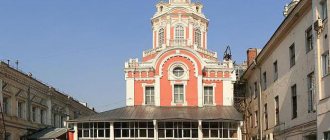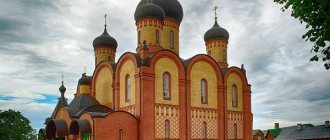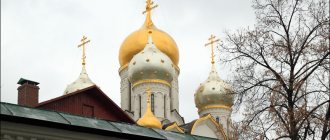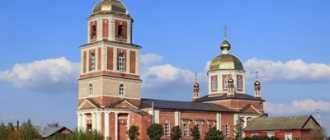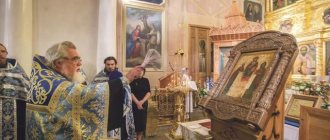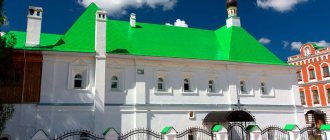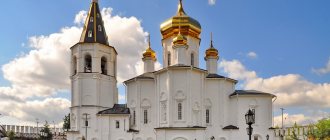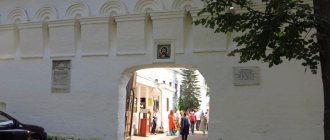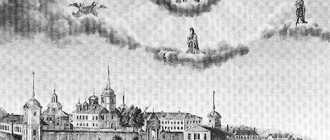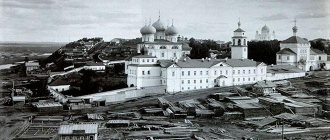Mir
Russia Moscow Vysoko-Petrovsky Monastery Map loading in progress...
{"format":"leaflet","minzoom":false,"maxzoom":false,"limit":50,"offset":0,"link":"all","sort":[""], "order":[],"headers":"show","mainlabel":"","intro":"","outro":"","searchlabel":"\u2026 \u0441\u043b\u0435\ u0434\u0443\u044e\u0449\u0438\u0435 \u0440\u0435\u0437\u0443\u043b\u044c\u0442\u0430\u0442\u044b","default":"","import-annotation":false,"width ":"auto","height":"350px","centre":{"text":"","title":"""link":"""lat":55.76729300000000222325979848392307758331298828125,"lon": 37.61434799999999967212716001085937023162841796875,"icon":""},"title":"","label":"","icon":"","lines":[],"polygons":[],"circles":[ ],"rectangles":[],"copycoords":false,"static":false,"zoom":8,"defzoom":14,"layers":["OpenStreetMap"],"image layers":[] ,"overlays":[],"resizable":false,"fullscreen":true,"scrollwheelzoom":true,"cluster":false,"clustermaxzoom":9,"clusterzoomonclick":true,"clustermaxradius":80, "clusterspiderfy":true,"geojson":"","clicktarget":"","showtitle":true,"hidenamespace":false,"template":"","userparam":"","activeicon": "","pagelabel":false,"ajaxcoordproperty":"","ajaxquery":"","locations":[{"text":"\u003Cb\u003E\u003Ca href=\"/palomnik/%D0% 92%D1%8B%D1%81%D0%BE%D0%BA%D0%BE-%D0%9F%D0%B5%D1%82%D1%80%D0%BE%D0%B2%D1%81 %D0%BA%D0%B8%D0%B9_%D0%BC%D1%83%D0%B6%D1%81%D0%BA%D0%BE%D0%B9_%D0%BC%D0%BE%D0 %BD%D0%B0%D1%81%D1%82%D1%8B%D1%80%D1%8C\" title=\"\u0412\u044b\u0441\u043e\u043a\u043e-\u041f\u0435\ u0442\u0440\u043e\u0432\u0441\u043a\u0438\u0439 \u043c\u0443\u0436\u0441\u043a\u043e\u0439 \u043c\u043e\u043d\u0430\u0441\u0 442\u044b\u0440\u044c\»\ u003E\u0412\u044b\u0441\u043e\u043a\u043e-\u041f\u0435\u0442\u0440\u043e\u0432\u0441\u043a\u0438\u0439 \u043c\u0443\u0436\u0 441\u043a\u043e\u0439\u043c \u043e\u043d\u0430\u0441\u0442\u044b\u0440\u044c\u003C/a\u003E\u003C/b\u003E\u003Chr /\u003E\u003Ca href=\"/palomnik/%D0%A1%D0%B2 %D0%BE%D0%B9%D1%81%D1%82%D0%B2%D0%BE:%D0%90%D0%BD%D0%BD%D0%BE%D1%82%D0%B0% D1%. \u044f\"\u003E\u0410\u043d\u043d\u043e\u0442\u0430\u0446\u0438\u044f\u003C/a\u003E: »'\u0412\u044b\u0441\u043e\u043a\u043e- \u041f\u0435 \u0442\u0440\u043e\u0432\u0441\u043a\u0438\u0439 \u043c\u043e\u043d\u0430\u0441\u0442\u044b\u0440\u044c"' \u2014 \u043e\u04 34\u0438\u043d\u0438\u0437 \u0434\u0440\u0435\u0432\u043d\u0435\u0439\u0448\u0438\u0445 \u043c\u043e\u043d\u0430\u0441\u0442\u044b\u0440\u0435\u0439 \ u041c\u043e\u0441\u043a\u0432 XIV 43e-\u041f \u0435\u0442\u0440\u043e\u0432\u0441\u043a\u0438\u0439 \u043c\u0443\u0436\u0441\u043a\u043e\u0439 \u043c\u043e\u043d\u0430\ u0441\u0442\u044b\u0440\u044c ""link":"","lat":55.76729300000000222325979848392307758331298828125,"lon":37.61434799999999967212716001085937023162841796875,"icon":" "}],"imageLayers":[]}
55.767296; 37.614527
Russia, Moscow, Petrovka street, 28с3
Moscow
Russia
Telephone.:
Email:
Vysoko-Petrovsky Monastery
- one of the oldest monasteries in Moscow, founded in the 14th century. In 2015, the 700th anniversary of the founding of the monastery is celebrated. Among its builders and benefactors: princes John Kalita and Dimitri Donskoy, Grand Duke Vasily III, Tsar Alexei Mikhailovich Romanov, Emperor Peter I, St. Philaret, Metropolitan of Moscow. Saints Mitrophan of Voronezh and Saint Tikhon, Patriarch of Moscow, performed divine services in the churches of the monastery. Nine clergy, monks and parishioners of the monastery were glorified in the Council of New Martyrs and Confessors of Russia. Founded during the lifetime of St. Peter the Metropolitan as Peter and Paul, after the death and canonization of the saint became Petrovsky. In the 1680-90s, it was rebuilt almost anew at the expense of the Naryshkins. Abolished by the Soviet government in 1926, returned to the Russian Orthodox Church in the beginning. 1990s In 1993, the former Vysoko-Petrovsky Monastery was given the status of a Patriarchal Metochion. The architectural ensemble is well preserved.
History[[edit]h2>
The Vysoko-Petrovsky Monastery was founded in the 14th century by St. Peter, Metropolitan of Kyiv and All Rus'. The saint moved the metropolitan see to Moscow, after which the city began to rise as the church and state center of Rus'. Among its builders and benefactors: princes John Kalita and Dimitri Donskoy, Grand Duke Vasily III, Tsar Alexei Mikhailovich Romanov, Emperor Peter I, St. Philaret, Metropolitan of Moscow. Saints Mitrophan of Voronezh and Saint Tikhon, Patriarch of Moscow, performed divine services in the churches of the monastery. Nine clergy, monks and parishioners of the monastery were glorified in the Council of New Martyrs and Confessors of Russia. The architectural ensemble of the Vysoko-Petrovsky Monastery was formed from the beginning of the 16th to the mid-18th centuries and represents a well-preserved architectural monument of the “Naryshkin Baroque”.
Vysoko-Petrovsky Monastery, old photos
The most ancient temple of the monastery - the Cathedral of St. Peter, Metropolitan of Kyiv and All Rus', was erected at the beginning of the 16th century by the architect Aleviz Fryazin, the builder of the Archangel Cathedral of the Kremlin. The cathedral was erected on the site of an older wooden church.
In 1684, during a pilgrimage to Bogolyubovo by Natalya Kirillovna and her royal son, Peter was presented with a copy of the miraculous Bogolyubo Icon of the Mother of God. For the sake of the miracles that came from this icon and in memory of his murdered uncles, the young king signed a decree on the construction of a stone church over the graves of his uncles in honor of the Bogolyubskaya Icon of the Most Holy Theotokos. He ordered the wooden Church of the Intercession to be dismantled and its throne moved to the new gate church planned at the same time in the monastery bell tower. A copy of the miraculous icon, brought by the Tsar from the Bogolyubsky Monastery, was placed in the Bogolyubsky Cathedral. The Bogolyubsky Cathedral of the monastery became the family tomb of the Naryshkin boyars, ancestors and relatives of Emperor Peter I.
The struggle of Peter I for power with his half-sister Sophia, who actually ruled the state for the young tsars, ended in his complete victory in 1689. This was preceded, however, by the flight of the 17-year-old tsar, informed of the impending assassination attempt by the archers, from Moscow to the Trinity-Sergius Monastery, under the protection of St. Sergius. In memory of this salvation and in gratitude to St. Sergius, by Decree of Peter I in 1690–93, on the border between the former territory of the Vysoko-Petrovsky Monastery and the former estate of the Naryshkins, a refectory church was erected in the name of St. Sergius of Radonezh, the prototype of which was the refectory built several years earlier Church in the Trinity-Sergius Monastery. As a sign of the special closeness of the monastery and the crowned family, the cross of the main dome of the Sergievsky and Bogolyubsky churches was crowned with the sign of the royal crown.
Church of St. Sergius of Radonezh with a refectory, 1890e
Significant damage to the monastery was caused during the Patriotic War of 1812. A thousand French cavalrymen stopped there for a while. All the churches of the monastery were desecrated and looted, although Archimandrite Ioannikiy managed to take the sacristy and especially valuable relics to Yaroslavl. Marshal Mortier, appointed military governor of Moscow by Napoleon, established his residence in the monastery. Here he sentenced to death Muscovites suspected of setting the city on fire. They were shot at the monastery walls from Petrovsky Boulevard and buried right there in the monastery, near the bell tower. At the same time, a slaughterhouse was established in the monastery. However, at the same time, the owner of the slaughterhouse decided to provide some kind of patronage to the monks who remained in the monastery and allowed them to perform divine services in one of the temples. According to the memoirs of contemporaries, the temple could not accommodate all the worshipers. Here, as in some other churches of occupied Moscow, prayers were offered during services for the victory of Russian weapons.
On September 9 (22), 1918, the last meeting of the Conference of Bishops on the rules of the work of the Holy Local Council of the Orthodox Russian Church took place in the Vysoko-Petrovsky Monastery. It was presided over by His Holiness Patriarch Tikhon. Saint Tikhon repeatedly performed divine services in the Vysoko-Petrovsky Monastery during the patronal feasts of the monastery churches.
According to the Decree “On the separation of church from state and school from church” of January 20 (February 2), 1918, all church property was nationalized. The last church on the territory of the monastery was closed in 1929.
Cathedral of the Bogolyubskaya Icon of the Mother of God, years of devastation
And even when the monastery was officially closed in 1918, and all church property was nationalized, it continued to operate secretly here in the 1920-1930s. It was the largest monastic community in the USSR, the life of which was built according to the monastic charter, where eldership flourished (taken over from Zosima and Optina Desert) and monastic tonsures were performed (and in order not to attract unnecessary attention from the authorities, work in secular institutions was charged to novices as sacred monastic obedience). Rectors of theological academies were often appointed abbots of the monastery. The monastery, despite its scarcity, provided its territory and buildings to needy church educational institutions: in 1786 ten students of the Slavic-Greek-Latin Academy found shelter here; from 1822 to 1834 - premises were provided for the Zaikonospassky district theological school; From 1863 until the revolutionary events of 1917, the Society of Lovers of Spiritual Enlightenment operated within the walls of the monastery, the diocesan library and the spiritual censorship committee of the Russian Church were located. She made all possible contributions to promoting a healthy lifestyle among the population - a branch of the Varnavinsky Temperance Society functioned within the walls of the monastery.
For several years after the revolution, the underground Moscow Theological Academy continued to operate within the community of the monastery.
The names of nine monks and parishioners of the monastery, canonized Russian saints who suffered martyrdom for Christ or were persecuted after the October Revolution of 1917, are associated with the “underground period” of the monastery:
- sschmch. Makariy (Gnevushev) - executed on September 4, 1918
- prpmch. Ignatius (Lebedev) - died on September 11, 1938 in custody
- prpmch. German (Polyansky) - shot in 1937
- prpmch. Fedor (Bogoyavlensky) - died July 19, 1943 in exile
- prpmch. Varlaam (Nikolsky) - executed on November 19, 1937
- prpmch. Makariy (Morzhov) - executed on June 10, 1931
- prpmch. Cosma (Magda) - executed in 1937
- m. Nikolai Varzhansky, organizer of the Varnavinsky Temperance Society - shot on November 19, 1918
- m. Ioann Popov, theologian, church historian, professor at the Moscow Theological Academy - shot in 1937].
Monastery complex
As mentioned earlier, on the territory of the monastery there is a whole complex of buildings: a cathedral, temples, a chapel and a bell tower. Let's talk about each of them in a few words.
Cathedral of St. Peter
The Cathedral of Peter the Metropolitan is the oldest building on the territory of the monastery. It is built in the form of an octagonal tower and topped with a helmet-shaped dome. Initially the cathedral was wooden, but at the beginning of the 17th century. it was rebuilt in stone. During the reign of Peter I, the cathedral was partially modified: the Naryshkins rebuilt it in the “Moscow Baroque” style. Only in the 20th century. St. Peter's Cathedral was restored to its historical appearance.
Temple of the Bogolyubskaya Icon of the Mother of God
The temple was built at the end of the 17th century by personal order of Peter the Great. Over the years of its existence, the building has undergone virtually no changes: all the same paired columns and keel-shaped kokoshniks framed by windows have survived to us. But in Soviet times, the unique iconostasis, dome and cross were destroyed. The latter were restored in the 80s. last century. For a long time, the temple served as a burial vault for members of the Naryshkin family: 18 representatives of the famous family were buried here.
Bogolyubskaya Church, © FotoGeorg
Church of St. Sergius of Radonezh
Another building erected by order of Peter I. It is located in the very center of the monastery complex. This is a two-story, three-apse quadrangle, with a refectory and a main entrance adjoining it from the west. It is noteworthy that in Soviet times this church housed a rehearsal hall for the dance group “Berezka”.
Gate Church of the Intercession of the Blessed Virgin Mary
The building, which was also erected by order of Peter the Great. It was dedicated to Ivan and Afanasy Naryshkin. The church with triple columns was built above the western gate of the monastery. It was ruined in 1812 and closed during Soviet times. The church was consecrated on the day of its 300th anniversary - in 1998.
Church of the Tolga Icon of the Mother of God
A single-domed building located between the bell tower and the Bratsk complex. It is known that it was erected at the expense of Naryshkina, a relative of Peter the Great on the maternal side. It is believed that Ivan Michurin, a prominent representative of the Moscow Baroque, worked on the church project.
Panorama of the territory of the Vysogo-Petrovsky Monastery
Church of Peter and Paul
The temple was built in the middle of the 18th century. at the insistence of Archimandrite Pachomius. The basis for its construction was the white stone gate of the Naryshkin estate. This is a brick building in the Baroque style, an octagon on a quadrangle. The church was seriously damaged in 1812, and two centuries later, in 2012, it was hit again when a construction crane fell on it, damaging the dome, cross and cornice.
Chapel of the Kazan Icon of the Mother of God
It was erected in 1905 in the southern bay of the monastery gate. 20 years later it was plundered and only in 2004 was it restored.
Monastic necropolis
Cemetery, where from the 15th century. monks and noble residents of Moscow were buried.
© mkdires
Current state[[edit]h2>
Since 1991, parish life began to be restored in the churches of the monastery and divine services were performed.
By the decision of the Holy Synod of October 10, 2009, at the request of Bishop Mercury of Zaraisk, a decision was made to revive monastic life in the Vysoko-Petrovsky Monastery. Bishop Mercury was appointed vicar of the monastery.
On February 20, 2010, the first Patriarchal service after a long break was held in the monastery and a new bell, the evangelist “St. Peter,” was consecrated.
The main shrine of the monastery is the revered icon with the holy relics of St. Peter of Moscow.
Necropolis
Since the 15th century, brethren and noble residents of Moscow have been buried in the monastery cemetery. During archaeological excavations, burials from the 17th century with sarcophagi and tombstones were discovered. Extracted from the ground, they are put on display at the southern wall of the Church of Sergei of Radonezh, awaiting burial.
The monastery territory, cutting into it like a wedge, is occupied by the walking and playground of kindergarten No. 878. The territorial dispute between the Vysoko-Petrovsky Monastery and the preschool institution is resolved by the Moscow government.
Shrines[[edit]h2>- cross with a piece of the Holy Cross
- Blachernae Icon of the Mother of God
- Kazan Icon of the Mother of God
- Tolga Icon of the Mother of God
- an image of the Mother of God “Inexhaustible Chalice” specially painted for the monastery with the upcoming saints
- icon of St. Peter's with a particle of the saint's relics
- app icon Peter and Paul with a particle of the relics of the apostles
- ark with particles of the holy relics of the Diveyevo saints
- ark with particles of the holy relics of the venerable fathers of Kiev-Pechersk
- reliquary with particles of 82 relics of saints and saints in the caves of the Holy Dormition Kiev-Pechersk Lavra
- relics of St. Mitrofan of Voronezh
Used materials
- Pages of the official website of the Moscow Patriarchate
- Historical sketch on the monastery website
- Stroev P.M., Lists of hierarchs and abbots of monasteries of the Russian Church
. - St. Petersburg, 1877. p. 172 - 175. - Readings at the Imperial Society of Russian History and Antiquities at Moscow University. Book One. January-March 1874. Lists of abbots of the Moscow Vysokopetrovsky Monastery since 1379
. Time-based publication under the direction of O.M. Bodyansky, January-March 1874. University printing house on Strastnoy Boulevard. M., 1874:
[1[1]Schiarchimandrite Hilarion (Levitsky), monk of St. Andrew’s monastery on Mount Athos,
[2[2]abbot of the Vysokopetrovsky Monastery (1885–1888),
How to get there[[edit]h2>
Directions:
to metro stations Chekhovskaya, Pushkinskaya, Tverskaya, Trubnaya
Address:
127051, Russia, Moscow, Petrovka street, building 28/2
Tel.:
+7 (Church of St. Sergius of Radonezh, for general questions)
+7 (office, fax)
+7 (HR service, accounting, legal service)
+7 (pilgrimage service, Maxim Lazarev)
Calls are accepted from Monday to Friday from 10:00 to 19:00.
Email:
[email protected] (Assistant Governor, Office)
[email protected] (pilgrimage service; Maxim Lazarev)
[email protected] (press service; novice Bogdan Semenyuk)
Official website: https://vpmon.ru/
Abbots, governors
- Peter (between 1437 - 1461)
- Job (between 1437 - 1461)
- Sergius I (1506)
- Jonah (1535 - 1544)
- Peter (1597 - 1600)
- Alexander (1634 - 1637)
- Euthymius (1641 - 1642)
- Paphnutius (1644 - 1645)
- Galaktion (1647 - 1648)
- N… N… (1654) (Dv. Zap., II, 219)
- Moses I (1655)
- Theodoret (1666 - 1668)
- Sergius II (1673 - 1675)
- Moses II (1676 - 1682)
- Joseph (1685 - 1688)
- Job (1690 - May 2, 1694)
- Joseph (Rimsky-Korsakov) (1694 - 1699)
- Joasaph (February 2, 1699 – September 22, 1708)
- Leonid (Petrovsky) (1709 - February 18, 1722)
- Sergius (Belogradsky) (March 3, 1722 - 1731)
- Avvakum (Lviv) (December 1731 - 1735)
- Pachomius (1735 - 1757)
- Joasaph (Khotuntsevsky) (May 12, 1757 - May 24, 1758)
- Joseph (Golden) (June 18, 1758 - December 17, 1761)
- Sylvester I (Stragorodsky) (March 5, 1760 - December 1760)
- Sylvester II (Yunitsky) (1762 - 1775)
- Theophylact (May 1775 - September 17, 1776)
- Sergius IV (September 15, 1776 - 1787)
- Melchizedek (Zabolotsky) (1787 - 1788)
- Ioannikiy (Gavrilovich) (August 28, 1788 - April 7, 1816)
- Lavrenty (Bakshevsky) (June 26, 1816 - January 19, 1819)
- Nikanor (Klementyevsky) (April 19, 1819 - March 28, 1826)
- Plato (Berezin) (1826 - 1828)
- Smaragd (Kryzhanovsky) (May 8 - August 23, 1828)
- Anastasy (Voskresensky) (1828 - 1830)
- Gabriel (March 28, 1830 - September 22, 1845)
- Eusebius (Orlinsky) (August 31, 1845 - 1847)
- Philofey (Uspensky) (May 22, 1847 - December 18, 1849)
- Evgeny (Sakharov-Platonov) (December 20, 1849 - October 6, 1857)
- Sergius (Lyapidevsky) (April 18, 1858 - August 8, 1859)
- Ioannikiy (Kholuysky) (August 10, 1859 - March 2, 1861)
- Savva (Tikhomirov) (November 4, 1862 - June 17, 1866)
- Ignatius (Rozhdestvensky) (August 7, 1866 - 1873)
- Grigory (Voinov) (1873 - ?)
- Joseph (Levitsky) (? - 1884 [1[1]/li>
- Veniamin (Petukhov) (September 3, 1885 - 1888 [2[2]/li>
- Nikifor (Bazhanov) (November 25, 1887 - 1890)
- Victor (Soloviev) (1890 - September 26, 1897)
- Pavel (Dobrokhotov) (October 21, 1897 - April 23, 1900)
- Seraphim (Golubyatnikov) (May 11, 1900 - 1904)
- Innokenty (Kremensky) (1904 - 1908)
- Lavrenty (Nekrasov) (1908)
- Makariy (Gnevushev) (February 11, 1908 - 1909)
- Nikodim (Shatunov) (1909 - 1918)
- Bartholomew (Remov) (1923 - 1929)
- closure of the monastery
The monastery is called Vysoko-Petrovsky because it stood on the steep bank of the river
Today's name of the monastery takes us back to the reign of Vasily III, when the Grand Duke ordered the construction of the first stone church on the territory of the monastery. The name of this temple was Petrovsky (in honor of St. Metropolitan Peter).
From that time (1517) the monastery received the official name Vysoko-Petrovsky (the first part comes from the steep bank rising above the Neglinnaya River).
Cathedral of St. Metropolitan Peter
